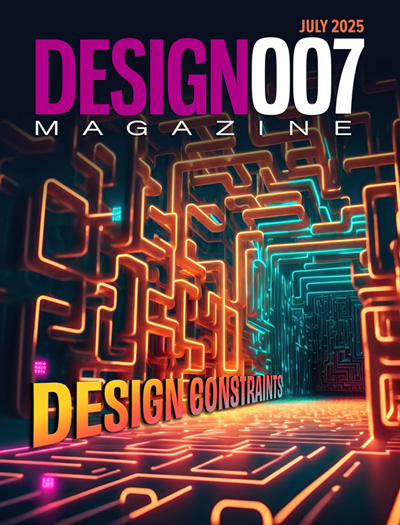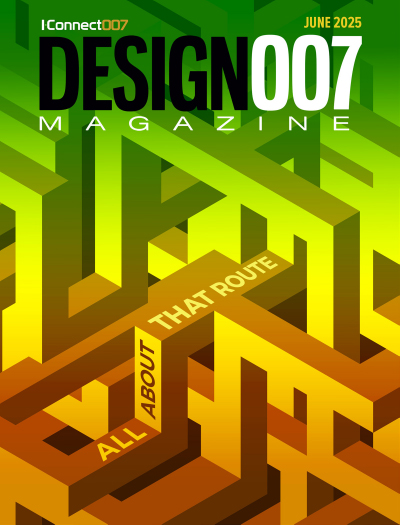-

- News
- Books
Featured Books
- design007 Magazine
Latest Issues
Current Issue
Proper Floor Planning
Floor planning decisions can make or break performance, manufacturability, and timelines. This month’s contributors weigh in with their best practices for proper floor planning and specific strategies to get it right.

Showing Some Constraint
A strong design constraint strategy carefully balances a wide range of electrical and manufacturing trade-offs. This month, we explore the key requirements, common challenges, and best practices behind building an effective constraint strategy.

All About That Route
Most designers favor manual routing, but today's interactive autorouters may be changing designers' minds by allowing users more direct control. In this issue, our expert contributors discuss a variety of manual and autorouting strategies.
- Articles
- Columns
- Links
- Media kit
||| MENU - design007 Magazine
CELUS Drops BOM on Electronics Design Complexity
March 5, 2025 | BUSINESS WIREEstimated reading time: 1 minute
CELUS, developer of the leading AI-assisted electronics design platform used by developers and engineers globally, unveiled a new bill of materials (BOM) experience that better satisfies the needs of electronic engineers by helping them choose the right components for the early stages of their PCB design.
Rather than spend days, weeks or months manually researching, evaluating and downloading product specifications for an array of components, engineers can now leverage an updated BOM view in the CELUS Design Platform. Expanded access to new pricing, lifecycle and supply information simplifies and accelerates the design process with automated, AI-driven recommendations of millions of components. Engineers are better positioned to assess supply chain risks prior to beginning the procurement process, ensuring that components are available to be sourced from manufacturers.
The CELUS Design Platform automates component search and schematic generation, enabling quicker, more accurate designs and capturing all requirements. The CELUS Design Platform’s proprietary AI algorithms then analyze specs and capabilities of available components to offer guided suggestions. A detailed component view emphasizes where the components are used and provides a list of alternatives that are accessible by clicking on the manufacturer parts number or descriptor in the BOM.
By optimizing the BOM design experience with additional data provided by Accuris, CELUS extends its market leadership as the global hub for electronic components and complete solutions. With electronic devices typically containing from 200 to 1,000 individual components, using CELUS radically shortens the time it takes to bring new projects from concept to reality – and to market.
“The ability to find the right components for electronic design projects is both overwhelming and time consuming,” said Tobias Pohl, co-founder and CEO of CELUS. “For the visionaries who might not know where to start with turning their design into a reality or the engineers that have pricing or manufacturing preferences to consider, having a system that provides this insight for every component within a circuit is life changing. The CELUS Design Platform with its new supply and pricing data minimizes the time spent on electronics design by recommending real-time component options that simply work, freeing makers to focus on the value of their projects rather than working on menial tasks to get them there.”
Testimonial
"Advertising in PCB007 Magazine has been a great way to showcase our bare board testers to the right audience. The I-Connect007 team makes the process smooth and professional. We’re proud to be featured in such a trusted publication."
Klaus Koziol - atgSuggested Items
Automation Meets Sustainability
09/08/2025 | Rick Nichols, GreenSource EngineeringGreenSource Engineering (GSE) is proud to have contributed to the first successful reshoring of a PCB facility on a greenfield site in the United States. While we are honored to have played a key role, full credit for this achievement goes to SEL for its vision, commitment, and professionalism.
Cadence to Acquire Hexagon’s Design & Engineering Business
09/08/2025 | Cadence Design SystemsCadence announced it has entered into a definitive agreement to acquire the Design & Engineering (D&E) business of Hexagon AB, which includes its MSC Software business—a pioneer in engineering simulation and analysis solutions.
Synopsys, GlobalFoundries Establish Pilot Program to Bring Chip Design and Manufacturing to University Classrooms
09/05/2025 | GlobalFoundriesSynopsys, Inc. and GlobalFoundries (GF) announced a new collaboration to launch an educational ‘chip design to tapeout’ program for universities worldwide.
I-Connect007 Editor’s Choice: Five Must-Reads for the Week
09/05/2025 | Andy Shaughnessy, I-Connect007It’s almost fall here in Atlanta, and that means that the temperature is finally dropping. And it quit raining! It’s been raining since March, and I’m so over it, as the social influencers say. Last night we grilled out on the deck, and it wasn’t hot, and we didn’t get rained on. Life is good. It was a busy week in the industry. In this installment of my must-reads, we say goodbye to Walt Custer, the man who made PCB data points interesting for the rest of us.
American Standard to Participate in European Microwave Week 2025
09/05/2025 | American Standard CircuitsAnaya Vardya, President, and CEO of American Standard Sunstone Circuits has announced that his company will once again be taking part in European Microwave Week, Europe’s premier RF, microwave, radar and wireless event, to be held from September 21-26, 2025 at Jaarbeurs in Utrecht, The Netherlands.


